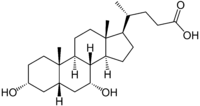Chenodeoxycholic acid
| Chenodeoxycholic acid | |
|---|---|
 | |
| IUPAC name chenodiol | |
| Identifiers | |
| CAS number | 474-25-9 |
| ChemSpider | 9728 |
| UNII | 0GEI24LG0J |
| DrugBank | DB06777 |
| KEGG | C02528 |
| ChEBI | CHEBI:16755 |
| ChEMBL | CHEMBL240597 |
| ATC code | A05 |
| Jmol-3D images | {{#if:C[C@H](CCC(=O)O)[C@H]1CC[C@@H]2[C@@]1(CC[C@H]3[C@H]2[C@@H](C[C@H]4[C@@]3(CC[C@H](C4)O)C)O)C|Image 1 |
| |
| |
| Properties | |
| Molecular formula | C24H40O4 |
| Molar mass | 392.57 g/mol |
| Melting point | 165-167 °C |
| Except where noted otherwise, data are given for materials in their standard state (at 25 °C (77 °F), 100 kPa) | |
| Infobox references | |
Chenodeoxycholic acid (also known as chenodesoxycholic acid and chenocholic acid) is a bile acid. It occurs as a white crystalline substance insoluble in water but soluble in alcohol and acetic acid, with melting point at 165-167 °C. Salts of this carboxylic acid are called chenodeoxycholates. Chenodeoxycholic acid is one of the 4 main organic acids produced by the liver.
Chenodeoxycholic acid is synthesized in the liver from cholesterol. It was first isolated in the domestic goose, hence the 'cheno' portion of its name (Greek: χήνα = goose) [1]
This compound, when altered by bacteria in the colon, will result in conversion to its secondary bile acid known as lithocholic acid. Both of these bile acids, in addition to the others, can be conjugated to taurine or glycine. Conjugation, a function carried out by the liver will result in a lowered pKa and therefore, the compounds will remain ionized. These ionized compounds will stay in the gastrointestinal tract until reaching the ileum where they will be reabsorbed. The purpose of this conjugation is to keep the bile acids in the tract until the end to facilitate lipid digestion all the way to the ileum.
In cases where bacteria overgrow in the small intestine, often due to a blind loop in the intestine retaining chyme in one place, the bacteria will de-conjugate the bile acids and therefore impede fat digestion and absorption. This can lead to steatorrhea.
Chenodeoxycholic acid and cholic acid are the most important human bile acids. Some other mammals synthesize predominantly deoxycholic acid.
Potential applications
The Australian biotechnology company Giaconda has developed a treatment for Hepatitis C infection that combines chenodeoxycholic acid with bezafibrate.
Chenodeoxycholic acid can be used in the treatment of cerebrotendinous xanthomatosis.
In supramolecular chemistry, molecular tweezers based on a chenodeoxycholic acid scaffold is a urea receptor that can contain anions in its binding pocket in order of affinity: H2PO4- (dihydrogen phosphate) > Cl- > Br- > I- reflecting their basicities (tetrabutylammonium counter ion).[2]
References
- ↑ Carey MC (December 1975). "Editorial: Cheno and urso: what the goose and the bear have in common". N. Engl. J. Med. 293 (24): 1255–7. doi:10.1056/NEJM197512112932412. PMID 1186807.
- ↑ Molecular Tweezer Based on Chenodeoxycholic Acid:Synthesis, Anion Binding Properties Ki Soo Kim, Hong-Seok Kim Bulletin of the Korean Society 1411-1413 2004 Article
| |||||||||||||
